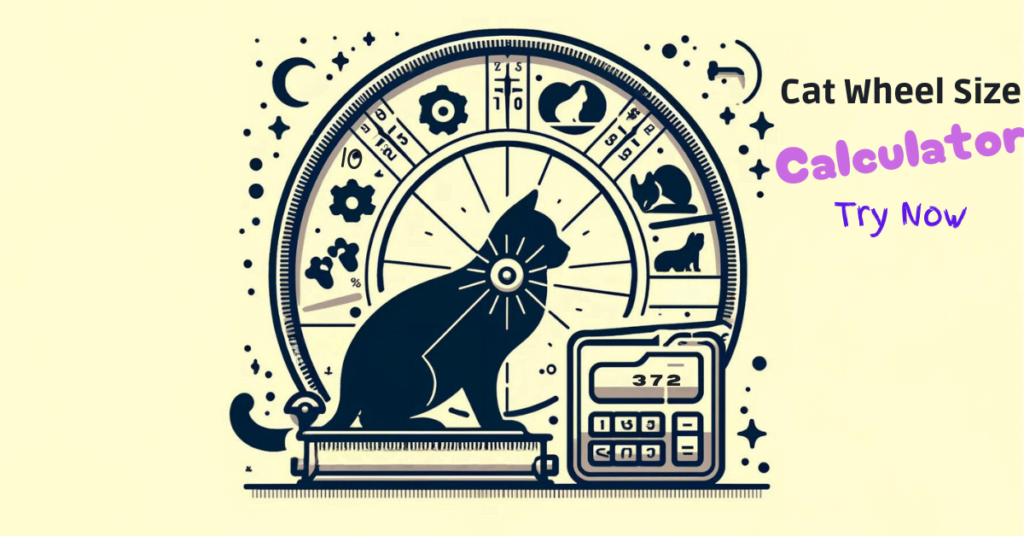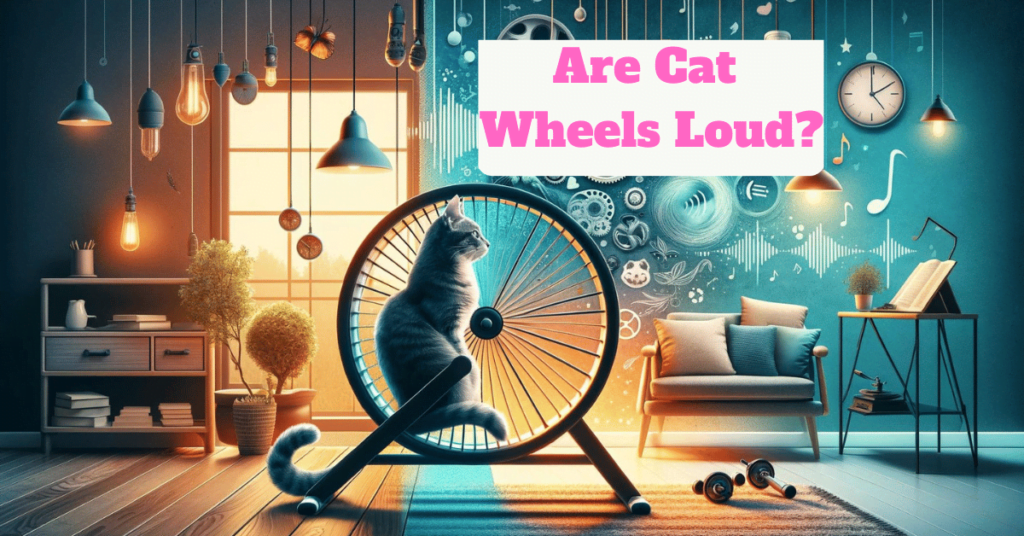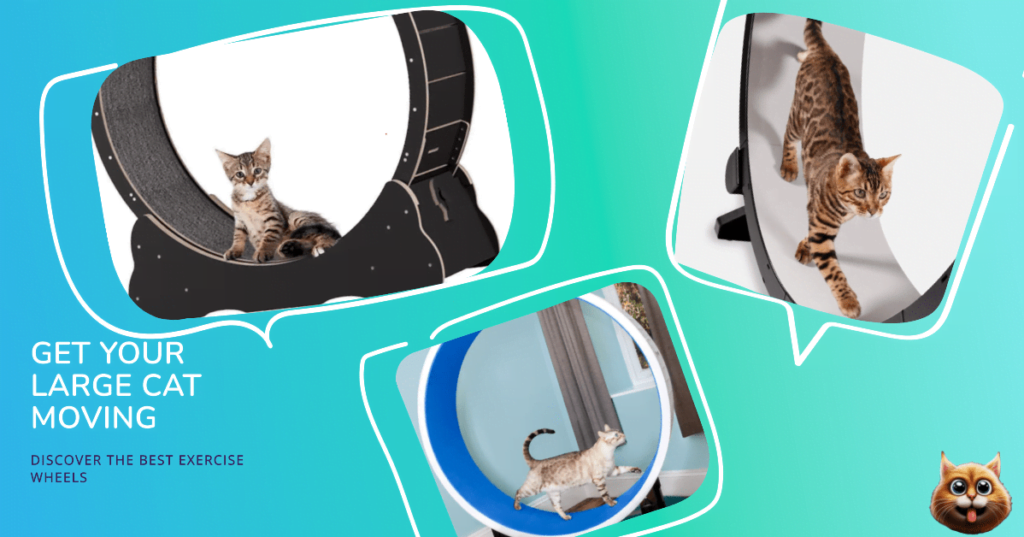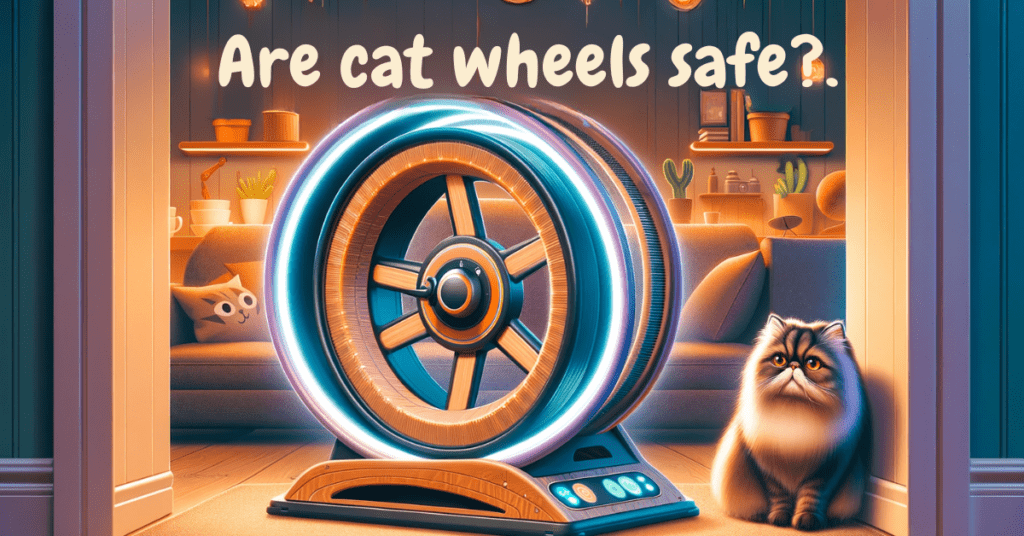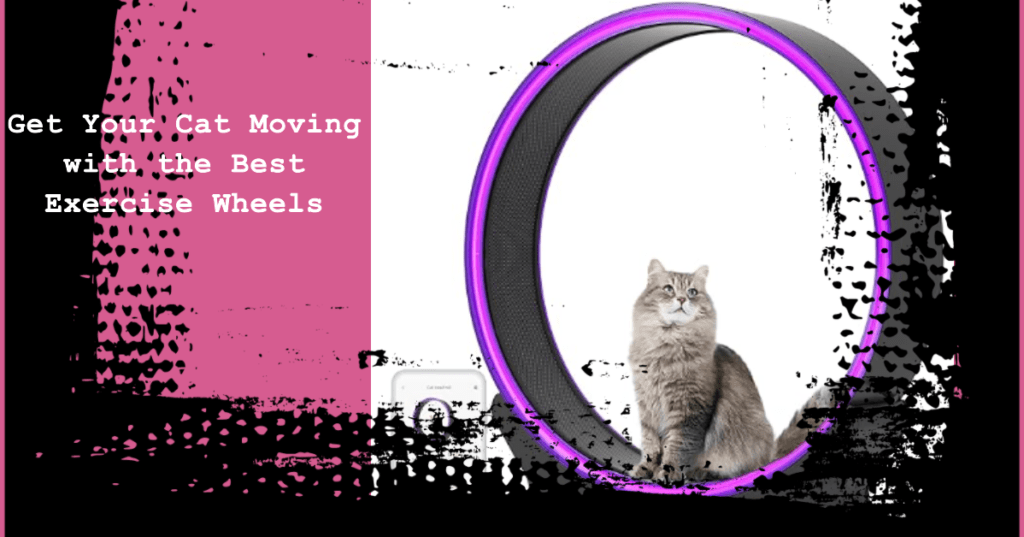This post contains affiliate links and I will be compensated if you make a purchase after clicking on my links.
Introduction
Choosing the right cat exercise wheel is a game-changer for your feline’s health and happiness. More than just a toy, this wheel is a vital tool to combat feline obesity and boost overall well-being. It’s like a personal indoor track for your cat, offering a safe space to run, play, or just stroll.
Packed with benefits, the cat exercise wheel not only helps with weight management but also improves mental health and curbs behavioral problems. It’s crucial, however, to get the size right. Too small, and your cat might be uncomfortable; too big, and it might be overwhelming.
This article focuses squarely on how to choose the right cat exercise wheel. We’ll dissect the key factors, from size to specific features, ensuring you select the ideal wheel for your cat’s unique needs. Gear up to step up your cat’s fitness game with the perfect exercise wheel!
Choose the Right Cat Exercise Wheel: Key Takeaways
Paws for a moment and check out these key takeaways — they’ll give you the gist of choosing the purr-fect cat exercise wheel in just a few minutes. But for those who want to dive deeper into the world of feline fitness, our full article is packed with more meow-velous insights and details! 🐾🎡
Understanding Your Cat’s Needs: Age, size, and activity level are key factors in choosing a cat exercise wheel. Young cats are more active, while older cats need wheels designed for comfort.
How to Choose a Cat Exercise Wheel?: Wheel size should match your cat’s size for comfort and safety. Material choice impacts durability and maintenance needs.
Cat Exercise Wheel Size Guide: Measure your cat from tail to nose to determine the right wheel size, ensuring the diameter is at least 1.5-2.5 times the cat’s length for optimal comfort.
Small vs Large Exercise Wheels: Smaller wheels are suitable for limited spaces and smaller breeds; larger wheels are better for larger breeds, offering more stability and space.
Safety Precautions: Wheeling Towards a Safe Haven: Correct wheel sizing is crucial for safety. Regular inspections and attention to the wheel’s surface, structure, and enclosure enhance safety during use.
Bottom Line: Select a cat exercise wheel that fits your cat’s size and activity needs, ensuring safety and comfort with a diameter at least 1.5-2.5 times the cat’s length. Choose durable materials and the right size—small for limited spaces, large for more stability—to enhance your cat’s well-being effectively.
Understanding Your Cat’s Needs
Before we sprint into the tech specs of cat exercise wheels, let’s paw-se for a moment and consider what makes your feline tick. Understanding your cat’s needs is the first step on the road to finding the ideal wheel for them to spin their nights away.
Age, Size, and Activity Level

Your cat’s age, size, and penchant for midnight escapades are crucial whiskers on the roadmap to the perfect wheel. Kittens and young adults, with their boundless energy and insatiable curiosity, will likely pounce on the wheel with the enthusiasm of a cat chasing a laser point.
However, as they saunter into their senior years (around 7 years and above), their zest for ceaseless spinning might wane. This study by Science direct shows the relationship between physical activity, cat age, and body condition score.
The good news? Cat exercise wheels are designed with our senior whiskered pals in mind, catering to their pace and comfort.
The size of your cat isn’t just about whether they’re a Mighty Maine Coon or a Dainty Domestic Shorthair. It’s about syncing with a wheel that matches their stride, ensuring they can prance with ease and confidence. A wheel that’s too small could feel like a cramped catnap, while a titan of a wheel might seem like a mountain too high to climb.
Fear not, for we shall whisker you through a Cat Wheel Size Guide later in this article to help decode the purr-fect wheel diameter for your cat, whether they’re a sprightly sprout or a seasoned senior.
How to Choose a Cat Exercise Wheel?
Let’s delve into the 5 core aspects that demand your attention:
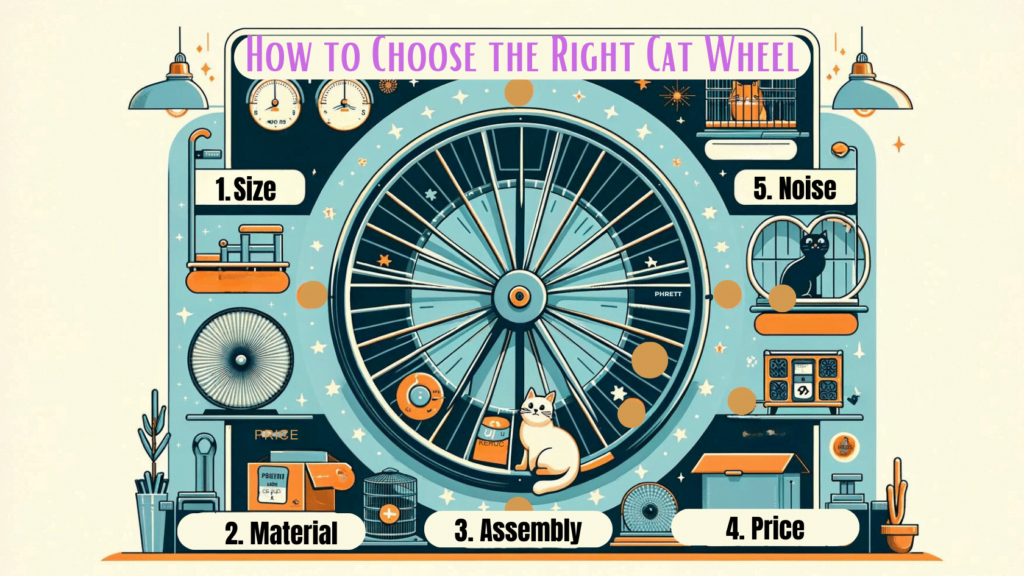
1. Wheel Size and Cat Size
The diameter of the wheel and the size of your cat are as correlated as a cat is to its curiosity. It’s essential to find a wheel that caters to your feline’s stature, ensuring they can stride with comfort and a whisker of confidence.
A well-fitting wheel ensures their back remains straight as they jog or sprint to their heart’s content, keeping them safe from potential injuries. A misfit wheel, on the other hand, could lead to an uncomfortable and even dangerous exercise experience.
A general rule of thumb is that the internal diameter of your cat should be 1.5 to 2.5 times its body length, though this can vary depending on the breed and its body structure.
Note: Later in this post, we’ll explain step by step how to find the exact size of a cat wheel. But for a simpler approach, you may use our Cat Wheel Size Calculator.
2. Material and Durability
Common catwalk materials range from sturdy plastics to sleek metals, each with its own set of claws and paws. Sturdy materials ensure the wheel remains stable as your cat runs the feline marathon, promising a durable exercise companion for years to come.
When it comes to different cat sizes, the material’s sturdiness becomes even more crucial. A heavier cat would require a wheel that holds its ground, while a lighter cat might do well with most materials. Besides, the material should be easy to clean because let’s face it, hairballs and shedding are part of the package deal in the cat ownership saga.
3. Ease of Assembly and Storage
The assembly process should be as smooth as a cat’s whisker, with clear instructions that guide you through each step without having to decode any feline hieroglyphics. A well-designed wheel should have you transitioning from box to brisk cat jogs in no time.
Once assembled, the ease with which you can store the wheel away when not in use is another paw-sitive feature to consider. Whether it’s a foldable design or a slim profile that slides seamlessly into a corner, a good wheel should marry functionality with convenience, ensuring your living space isn’t entirely overtaken by the cat’s new fitness regime.
4. Price and Brand Reputation
The price tag on cat exercise wheels can range from a modest mouse to a royal Bengal ($100 – $1000), catering to various budget brackets.
While splurging on a high-end wheel might bring more bells and whiskers, it’s important to remember that cat wheels don’t have to be very expensive.
Reputable brands often have a trail of satisfied customers and strong reviews purring in their favor. Brands that have clawed their way to a reputable standing often offer better customer support, warranties, and often, a better-quality product.
5. Noise Level
Nobody wants a cat wheel that disrupts the tranquility of their home. While gauging noise levels without firsthand experience can be challenging, rely on the feedback of fellow cat enthusiasts to ensure your chosen wheel harmonizes seamlessly with your living space.
Opt for a model that whispers rather than roars, which will ensure a peaceful environment for both you and your furry friend.
Cat Exercise Wheel Size Guide (Step-by-step)

Measuring Your Cat
The road to the purr-fect cat exercise wheel begins with a tape measure in hand and a cat (hopefully) at a standstill. Measuring your cat is the prologue to our story of endless spins and whisker-twitching workouts.

So, let’s pounce into the step-by-step guide to measuring your feline companion:
Step 1: Prepare Your Cat
Encourage your cat to stand still. It might take a few treats or a gentle touch to achieve a moment of feline zen. Once your cat is standing comfortably, it’s time to bring out the tape measure.
Step 2: Measure the Length
Now, measure the length of your cat from the base of the tail to the tip of the nose, while they’re standing. This measurement will help in understanding how much space your cat needs to stretch out fully on the wheel.
Step 3: Determine Wheel Size
Now that you have your cat’s measurements, it’s time to play wheel whisperer. The diameter of the wheel should be at least 1.5-2.5 times the length of your cat, ensuring they can stretch out and run without their body curving uncomfortably.
For example, if we consider the average length of a male cat to be 12 inches, the recommended wheel diameter would be calculated as follows:
Wheel Diameter = 12 inches×1.5 = 18 inches
Thus, a wheel with a minimum diameter of 18 inches would be suitable for a male cat with an average length of 12 inches. This is the absolute minimum, so the bigger the better.
While diameter takes center stage in wheel sizing, the width of the wheel is the supporting act that can’t be ignored. A minimum width of 12 inches is advisable, though a greater width is often more beneficial, providing ample space for your cat to move and maintain balance. Typically, the width tends to be proportional to the diameter, aligning with the overall wheel dimensions to create a harmonious, well-fitted exercise wheel.
Understanding how your cat’s dimensions correlate with the wheel size is like decoding the meowtrix. A well-fitted wheel allows for a natural stride, ensuring your cat can sprint, bound, or leisurely stroll with ease and safety.

Small vs Large Exercise Wheels
The spectrum of small to large wheels each comes with its unique set of boons and caveats. Grasping these distinctions can empower cat guardians to make a well-informed choice. Here’s a comparative table to assist you in juxtaposing the merits and demerits of each:
| Feature | Small Wheels | Large Wheels |
|---|---|---|
| Space Requirement | A compact choice, ideal for cozy living quarters. | Demands more space, fitting for expansive areas. |
| Weight | Feather-light, simplifying mobility and setup. | Heftier, may pose challenges in relocation. |
| Suitability | A match for petite cat breeds or fledgling kittens. | Tailored for larger breeds or cats coveting more gallop room. |
| Stability | May falter in stability, especially with vivacious cats. | Generally robust and stable, paving the way for a smoother gallop. |
| Growth Accommodation | Offers scant growth room; may fall short as the cat matures. | Embraces a cat’s growth, promising long-term utilization. |
Peering both at the present stature and potential growth trajectory of your cat is elemental in wheel selection. This foresight ensures the wheel continues to serve as a snug and delightful exercise haven for them, accompanying their leaps and bounds through various life stages.
Safety Precautions: Wheeling Towards a Safe Haven
The right wheel size isn’t merely about gallop space; it’s the keystone of a safe and enjoyable exercise journey for your cat. The resonance between your cat’s dimensions and the wheel’s diameter is crucial to prevent awkward body curvature, ensuring a natural stride. Additionally, a well-fitted wheel is less likely to tip or wobble, bolstering the safety milieu.
Beyond size, other safety canvases await your attention. The safety manual includes chapters on ensuring the wheel’s surface is grippy yet gentle on paws, the structure is sturdy, and the enclosure is free from protruding parts that could snare a curious paw or tail. Regular inspection for wear and tear, keeping the wheel’s surrounding area clear, and supervising initial use can also sketch a safer exercise narrative.
In Conclusion: Wheeling Towards Whiskered Wellness
Selecting the ideal exercise wheel is a crucial step toward fostering a healthy and engaging environment for your feline companion. The correct wheel size, tailored to your cat’s needs, ensures safe and enjoyable workouts.
We discussed various factors in choosing the right cat wheel, including size, assembly, safety, noise, and price. By comparing small and large wheels and considering these important aspects, you are well-equipped to make an informed decision that benefits both you and your cat.
Frequently Asked Questions
Are cat exercise wheels worth it?
Yes, especially for indoor cats. They provide a great way for your cat to exercise, which is good for their physical and mental health.
How do I know if my cat will use a cat wheel?
Whether your cat will use a cat wheel often depends on their breed and energy level. High-energy cats are more likely to make use of it. To encourage your cat, introduce the wheel gradually using treats or toys. Every cat is unique; while some may take to it immediately, others may require a bit more time to warm up to the idea.
Will an older cat use a Cat Wheel?
Kittens, senior cats, those charming flat-faced (brachycephalic) breeds, or any kitty that’s more couch potato than athlete, might not find the wheel to be their cup of tea. Instead, stick to the classics—traditional toys are more their speed.
Meet Sean, a fintech whiz with a penchant for pet purrs and blockchain buzz. After a decade of fintech feats, Sean’s tech talents leaped from ledger lines to litter lines, driven by a passion for pets and a vision for a more connected pet care community. With three critter companions as co-pilots, Sean launched this blog to share a treasury of pet-friendly tech tips and tales.




